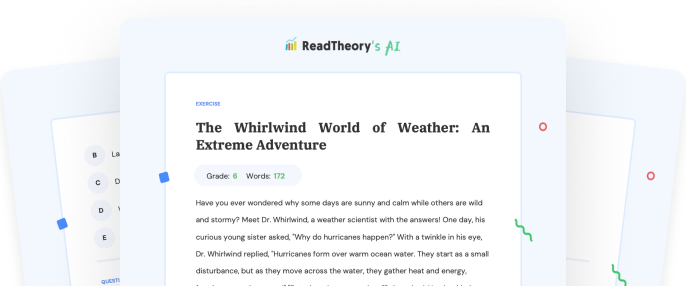Transform Your Teaching
with AI-Powered Worksheets
With ReadTheory’s Instant Worksheet Builder, you can create engaging, grade-appropriate worksheets tailored to your students in minutes. Spark curiosity, save time, and empower critical thinking with AI-powered tools designed for teachers like you.


The White House: More than a Presidential Residence
In 1792, the cornerstone was laid for a residence that would eventually become a globally recognized symbol of democracy - the White House. Located at 1600 Pennsylvania Avenue, this iconic building serves not just as a home to the U.S. Presidents, but also as a nerve center of American political power. Constructed with Aquia Creek sandstone painted white, it was the architect James Hoban’s design that won the national competition for this prestigious project. Surviving fires and reconstructions, the White House stands tall, hosting numerous events, from state dinners to peace treaty signings. The White House is more than just a presidential residence; it is a dynamic hub where critical decisions influencing global politics are made. Within its rooms, strategies are formed, laws are conceptualized, and actions are initiated that echo across the world. It is a testament to the resilience and strength of the nation it represents. Yet, the White House also has a lesser-known side. Did you know it has a tennis court, a jogging track, a swimming pool, a movie theater, and even a putting green? Or that the complex includes 132 rooms, 35 bathrooms, and 6 levels? Such fascinating details make the White House as intriguing as it is important. In essence, the White House is not just an architectural marvel or a seat of power. It is the beating heart of a nation, a symbol of the enduring American spirit and a testament to the country's rich history.
Question 1
What year was the cornerstone laid for the White House?
1759
1792
1800
1823
1846
Question 2
Who was the architect of the White House?
Thomas Jefferson
Benjamin Franklin
George Washington
James Hoban
Andrew Johnson
Question 3
What is the White House made of?
Granite
Marble
Limestone
Brick
Aquia Creek sandstone
Question 4
How many rooms does the White House have?
50
75
100
132
200
Question 5
What is the White House a symbol of?
Power
Freedom
Democracy
Justice
Equality
 or share via
or share via

Assign the ReadTheory pretest to determine students' reading levels.

Why Teachers Love
Instant Worksheet Builder?

Tailored Content for Every Student
Craft worksheets with passages and multiple-choice questions customized to your chosen topic and grade level, ensuring relevance and engagement.

Save Hours
of Prep Time
Our AI, Lexi, generates complete worksheets—passages, questions, and answers—in minutes, freeing you to focus on teaching, not planning.

Standards-Aligned Learning
Every worksheet is designed to boost reading comprehension and critical thinking, aligning seamlessly with State Standards to help your students shine.
Personalized teaching
for personalized learning
Browse worksheets created and refined by educators using Lexi—your source for inspiration and ready-to-use resources.


ReadTheory is free for Teachers to use.
Join thousands of educators using ReadTheory for free. Sign up today and start creating in just minutes!





